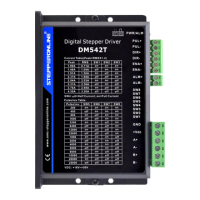DM542T Full Digital Stepper Drive Manual
3. Pin Assignment and Description
The DM542T has two connectors P1&P2, P1 is for control signals connections, and P2 is for power and motor
connections. The following tables are brief descriptions of the two connectors. More detailed descriptions of the pins
and related issues are presented in section 4, 5, 9.
Connector P1 Configurations
Pulsesignal: In single pulse (pulse/direction) mode, this input represents pulse signal, each
rising edge active; 4-5V when PUL-HIGH, 0-0.5V when PUL-LOW. The DM542T drive has
no double pulse mode (pulse/pulse). For reliable response, pulse width should be longer
than 2.5μs. Series connect resistors for current-limiting when +12V or +24V used (1K for
+12V, 2k for +24V). The same as DIR and ENA signals.
DIRsignal: In single-pulse mode, this signal has low/high voltage levels, representing two
directions of motor rotation; The DM542T drive has no double pulse mode (pulse/pulse). 4-5V
when DIR-HIGH, 0-0.5V when DIR-LOW. Please note that rotation direction is also related to
motor-drive wiring match. Exchanging the connection of two wires for a coil to the drive will
reverse motor direction.
Enablesignal: This signal is used for enabling/disabling the drive. High level (NPN control
signal, PNP and Differential control signals are on the contrary, namely Low level for
enabling.) for enabling the drive and low level for disabling the drive. Usually left
UNCONNECTED (ENABLED).
Connector P2 Configurations
Pin Function Details
GND Power Ground.
+V Power supply, 20~50 VDC, Including voltage fluctuation and EMF voltage.
A+, A- Motor Phase A
4. Control Signal Connector (P1) Interface
The DM542T can accept differential and single-ended inputs (including open-collector and PNP output). The
DM542T has 3 optically isolated logic inputs which are located on connector P1 to accept line drive control signals.
These inputs are isolated to minimize or eliminate electrical noises coupled with the drive control signals.
Recommend using line drive control signals to increase noise immunity for the drive in interference environments. In
the following figures, connections to open-collector and PNP signals are illustrated.

